18 January 2024
The true story of Perret & Berthoud, manufacture des montres Universal. Part one: history
By Joel Pynson

“We have to get to the point where customers demand not just a watch, but a Universal from their watchmaker.”
Raoul Perret
For many watch collectors, Universal is one of the finest Swiss brands. Mythical models such as the Tri-Compax chronograph and the Polerouter automatic watch have done much to enhance the reputation of Swiss watchmaking around the world.
The company’s eventful history is, as is often the case, difficult to reconstruct[1]. The many changes at the head of the company, and the numerous moves, explain the absence of reliable archives, and the information available on the Internet is rather fanciful. It is therefore necessary to delve into trade publications of the period to try and piece together the story of the company and the men who built it.
- History of the company
1.1 From Descombes & Perret to Bulova
The story of Universal began in Le Locle on January 1, 1894, when Numa-Émile Descombes and Georges-Ulysse Perret founded Descombes & Perret as a watchmaking business[2].

Emile Descombes and Ulysse Perret knew each other well. They had worked together for a subsidiary of Bergeon, the famous supplier of watchmaking tools, in Livorno, Italy. There, they had met Louis Berthoud, an accountant from Neuchâtel who would later play a major role at Universal[3].
Descombes and Perret certainly wanted to stand on their own two feet, and chose Le Locle, the Mecca of chronometry, to set up their own business.
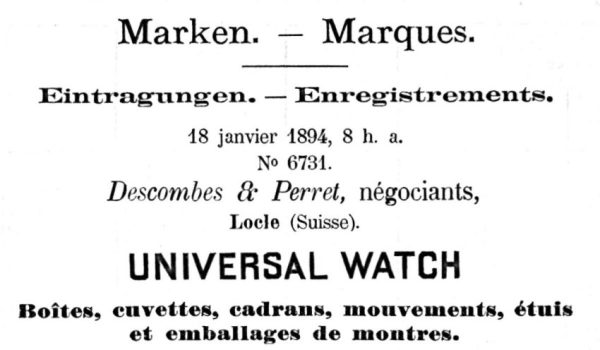
The Universal Watch trademark was registered in 1894, the year the company was founded. Numerous other brands followed: Uso Ferrovie, Cronometro Ferroviario, Uso Militari, La Meridiana, Cronometro Maritimo, Edera, Lys, Lepantos, Thermos, Orologio della Ferrovia, Mirus, Urbe and others. Most of these brands have an Italian ring to them: the Italian market is the first to be explored. In fact, Émile Descombes’ wife was Italian, and the Descombes & Cie company that distributed Universal watches, as well as Zenith watches, was based in Milan.
Little is known about the first watches marketed by Descombes & Perret. The company started out as a sales counter, distributing watches from several other brands in Italy, including some made in their own name[4]. But the manufacturing idea was already there: in 1894, Descombes et Perret filed a patent for a jumping-hour watch[5], and in 1896 another patent for a Roskopf-type watch[6].
In 1895, Louis Berthoud joined the company of his former colleagues. But in a terrible twist of fate, Émile Descombes died suddenly in 1897. Georges Perret proposed to Louis Berthoud that they join forces to create the company “Perret & Berthoud[7]“. These two names would be associated with the Universal brand for over 50 years.

Perret & Berthoud watches are successful in Italy, and their reputation grows. At the 1906 Milan International Exhibition, they won a gold medal[8].
4 years later, in 1910, Universal opened a second market: Spain. A subsidiary was opened in Madrid, and a new salvo of brands was registered: Edera, Lys, Lepantos, Thermos, Mirus, Urbe, Ultus, Domo, Universal Watch Extra, etc.
In 1914, Perret & Berthoud obtained a 1st class bulletin from the Bureau Officiel de Contrôle in Le Locle[9]. The company had in fact gradually become an “établisseur”, i.e. a factory placing orders with subcontractors to manufacture its own watches, and the quality of their manufacture was attested by the chronometer bulletin obtained.
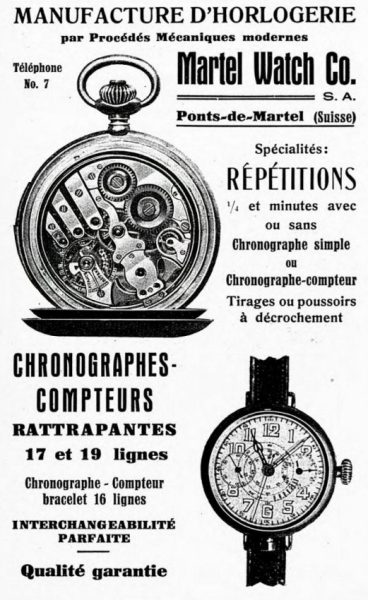
Advertising from 1916
Around 1917, at the request of the Italian army, Perret & Berthoud produced their first wrist chronograph[10]. Several other manufacturers already had this type of watch in their range, including Breitling, Omega, Longines and Nathan Weil. But it was undoubtedly Perret & Berthoud’s strong presence in Italy that played into the Locle manufacturer’s hands. It is highly likely that the movements for these wrist chronographs were supplied by Martel Watch. This factory, founded in 1911 in Le Locle by Georges Pellaton, was transferred to Les Pont-de-Martel in 1915[11], and subsequently became the official supplier of Universal chronograph calibres. Universal chronograph wristwatches of the same period with Jeanneret-Lémania calibers are also known.
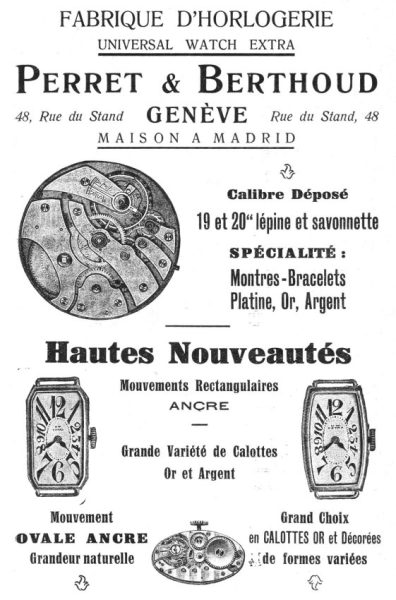
Advertising from 1920
By 1918, Perret & Berthoud had a complete range of wristwatches in silver, platinum and gold, some bearing the UW Extra (Universal Watch Extra) trademark, and decided the following year to transfer their headquarters to Geneva, at 48 rue du Stand[12]. The move was no doubt motivated by a desire to move upmarket and benefit from the city’s reputation. In fact, wristwatches of various shapes and richly decorated designs soon began to appear. Two years later, in 1921, the company moved to the prestigious Rue du Rhône, at no. 43.
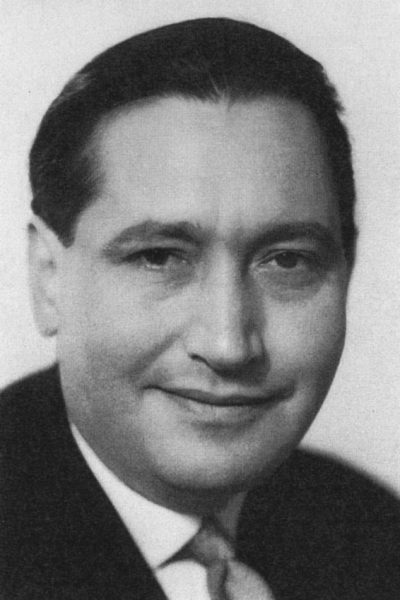
Raoul Perret
In 1923, the company became a S.A. and a major event occurred: the arrival of Raoul Perret, son of Georges-Ulysse. Raoul Perret was born in 1901. He graduated from Le Locle business school and watchmaking school, and was a pupil of the famous watchmaker James Pellaton. At the age of 19, he started out as a salesman for his father’s company in Spain and Italy, which taught him about the demands of the markets and the realities of the field. A lover of art and aesthetics, he took an early interest in the design of the company’s models, and it was he who left his mark on the Universal Genève manufacture for over 40 years.
In 1932, Raoul Perret, who was only 31, became director of Perret & Berthoud. These were years of crisis for the Swiss watchmaking industry, which underwent an in-depth reorganization, with the creation of ASUAG and watchmaking trusts such as Ébauches SA, which, with the support of the Swiss Confederation, imposed the “statut horloger”. This status imposed the choice of being a Manufacture and producing its own ébauches, or sourcing from Ébauches SA and not manufacturing its own movements. Perret & Berthoud courageously opted for the manufacture status, which was admittedly more risky, but allowed greater freedom in the creation of movements. For this, it was better to rely on other manufactures, as transfers between manufactures were authorized. In 1934, Raoul Perret joined the board of directors of the famous Zenith Manufacture in Le Locle[13], while securing the services of Martel Watch for its chronograph calibers.
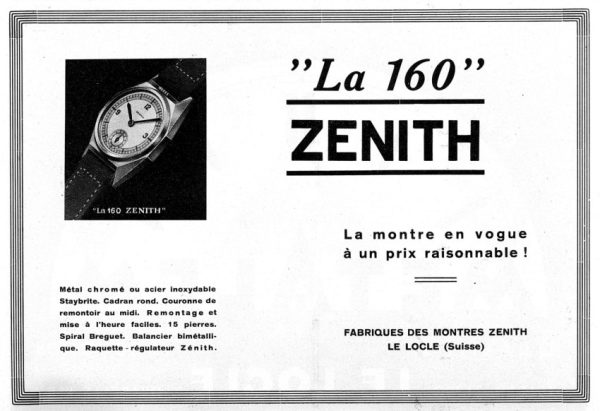
Advertising from 1935
Georges Perret died in 1933. Raoul Perret was now able to implement his strategy to make Perret & Berthoud and Universal a brand in the firmament of Swiss watchmaking: specialization in chronographs and “Geneva quality” watches, and exploration of new markets in Europe and the Americas.
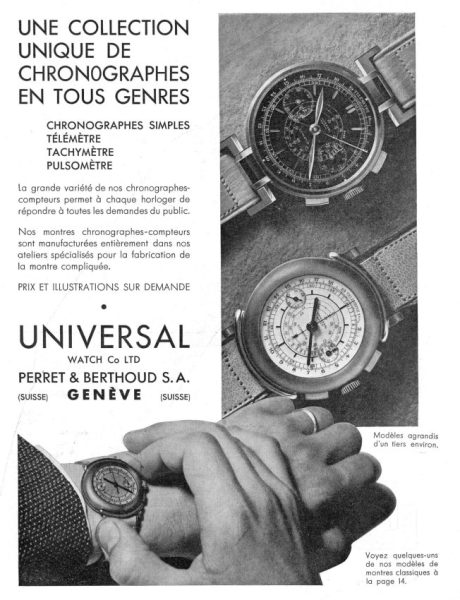
Advertising from 1935
The Compur trademark was registered in 1934, and the following year a whole range of chronographs was launched, proudly exhibited at the 1935 Basel Fair. They all had two pushers, and were among the first, along with Breitling and Angélus, to feature this improvement. All cases are of high quality: gold or steel, whereas stainless steel, very expensive at the time, had only been introduced into Swiss watchmaking a few years earlier. From then on, the Universal Watch Genève brand appeared most often on dials, even though the company’s official name was still Perret & Berthoud.
The company began to explore other markets. By 1936, Universal was represented in France, Germany and the UK. It also set up an efficient advertising department, with regular advertisements appearing in the Swiss trade press and the European consumer press.
In 1940, the company became Manufacture des montres Universal, Perret & Berthoud SA, thus affirming its status as a manufacturer and consolidating the use of the Universal brand. The range of Universal calibers expanded considerably: over a dozen for wristwatches, from the small 5-line square caliber (11.50 x 16.00 mm) to the 12-line round caliber (23.30 mm).
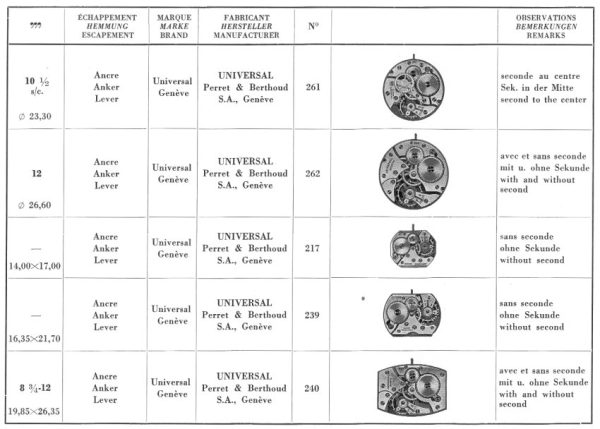
Universal’s calibres, 1939
In the same year, Raoul’s brother René Perret joins the company. The company’s premises on rue du Rhône in Geneva are enlarged, and now occupy 2 floors of the building[14].
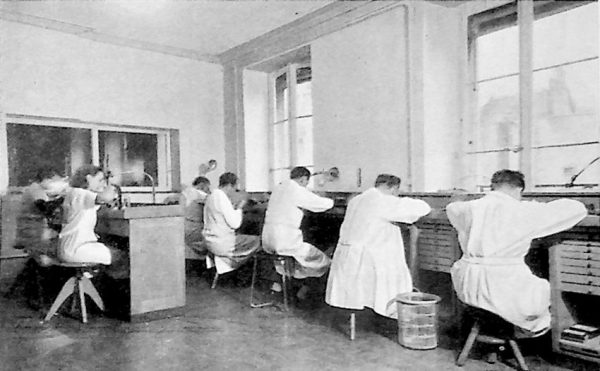
Universal’s workshops, 1940
World War II had little effect on Swiss watchmaking. The number of timepieces exported actually increased, and sales more than doubled between 1939 and 1945, despite raw material shortages and supply difficulties. This no doubt explains the optimism of Universal’s directors, who had a new factory built in Les Ponts-de-Martel in 1941, where chronographs and complicated timepieces (non-chronograph watches with calendar)[15] were manufactured.
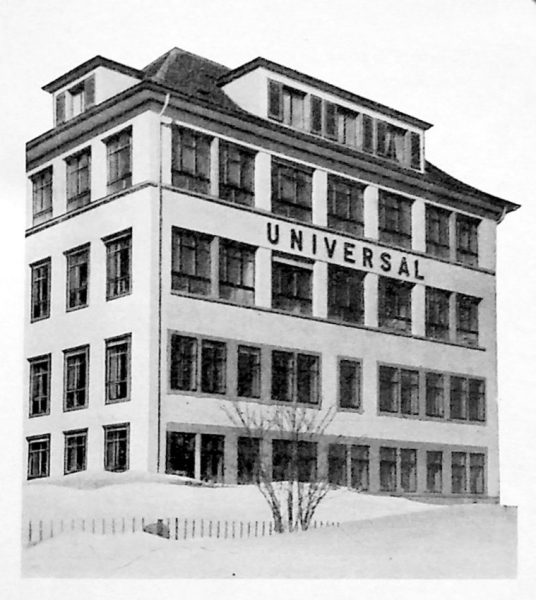
Universal factory in Les Ponts-de-Martel, 1941
Built in 5 and a half months, it housed modern tooling and produced, in particular, the Aero-Compax chronograph, as well as a totalizing chronograph for aircraft. During the war, Swiss manufacturers were in great demand to produce military equipment. The following year, Georges Pellaton, head of Martel-Watch, died. Raoul Perret took over the management of the company, securing exclusive rights to the movements[16]. In the same year, he left the Zenith Board of Directors[17].
It was also during the Second World War that Universal moved into the American market, setting up the Universal Geneva Watch Co. in New York. The company’s arrival in the most important market for Swiss watchmaking gave it a truly international dimension.
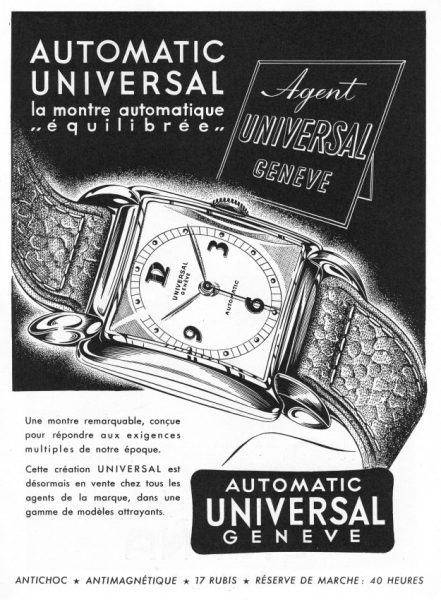
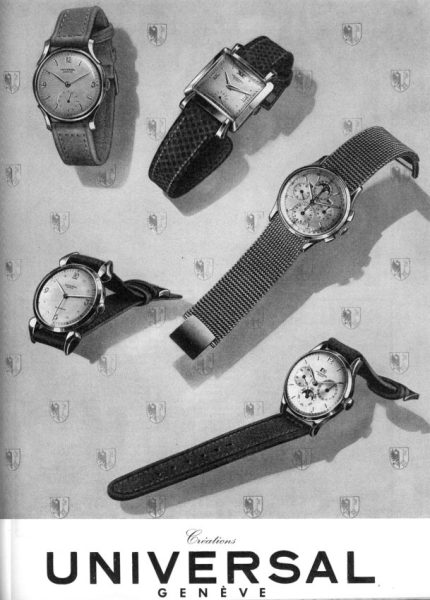
Advertising from 1948
In 1945, Louis-Edouard Berthoud left the company. He died two years later. From then on, the Perret brothers ran the company with even greater dynamism: as early as 1948, the first manufacture automatic watches[18] appeared (caliber 138 with classic bumper), as well as the first calendar watches and superb watches with cloisonné enamel dials.
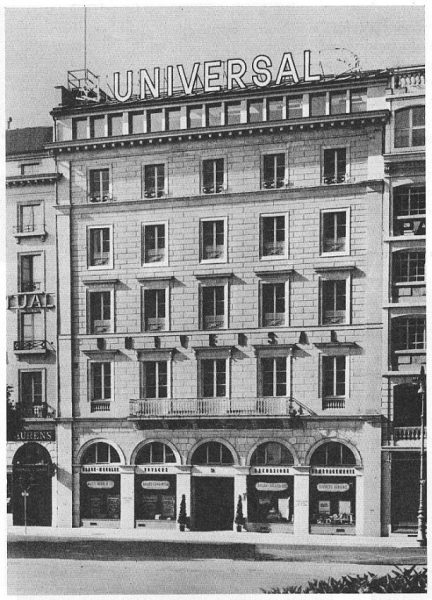
Universal’s building in Geneva, 1949
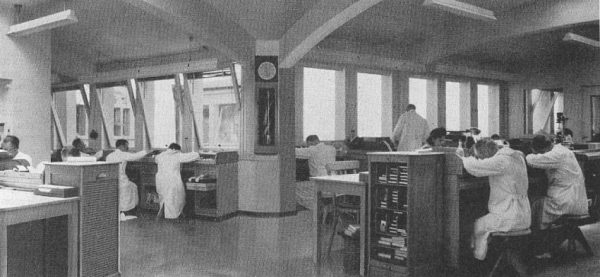
Universal’s workshops, 1949
In 1949, the Geneva building was completely modernized[19]. Light was now everywhere, and the attic space was converted to accommodate the workshops, which benefited from natural daylight. This is also the year of the launch of the Monodate model, a watch with a date window at 3:00, a design typical of the fine Swiss watches of the 1950s. The automatic version of the Monodate was launched in 1951.
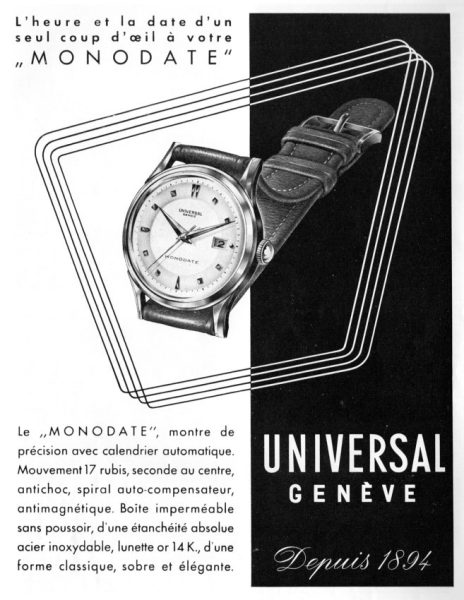
Advertising from 1950
Between 1951 and 1955, Universal’s corporate structure gradually changed. First with the creation of the Société de vente des montres Universal SA (1951), then with the creation of Perret Frères (1953), which took over several patents from Perret & Berthoud, and finally in 1955 with the modification of the manufacture des montres Universal, Perret & Berthoud, which became Montres Universal, Perret & Berthoud SA, a company dedicated to the marketing of Universal watches; and finally with the transformation of Perret Frères into Manufacture des montres Universal, Perret Frères, which handles manufacturing and sales.
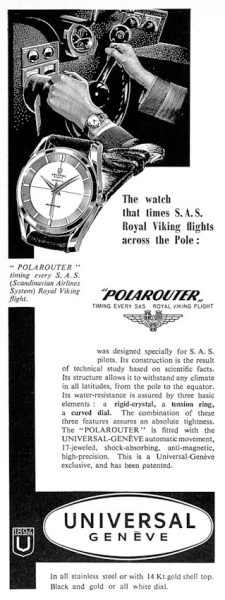
Advertising from 1955
The famous Polerouter model, discussed below, was launched in 1955, and the following year Universal inaugurated a new factory in Carouge, near Geneva[20]. The superb building, designed by architect Davoine, who also built other watch factories in Switzerland, features 60% glass facades. The machine park rests on a concrete slab anchored in the ground to avoid vibrations. The control rooms are air-conditioned and soundproofed. The master clock is controlled by a quartz clock and distributes the exact time throughout the workshops.
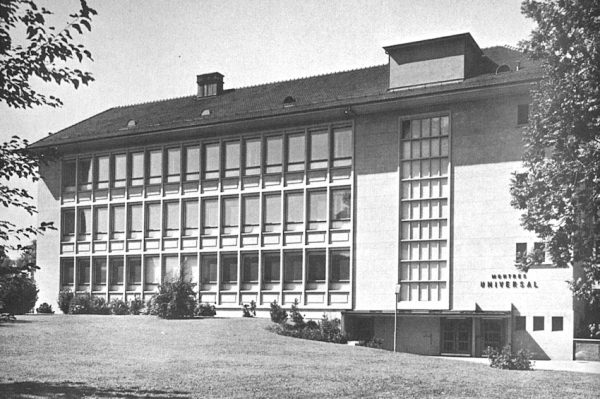
Universal’s factory in Carouge, 1966
Also in 1956, Raoul Perret leaves Martel Watch, replaced as president by Raoul Pellaton. This was a turning point for Universal, as the chronograph was gradually dethroned in the company by automatic watches and jewelry watches. The chronograph became less sought-after on international markets, and Universal followed a general trend. Put into difficulty by Universal’s departure, Martel Watch was bought by Zenith in 1960.
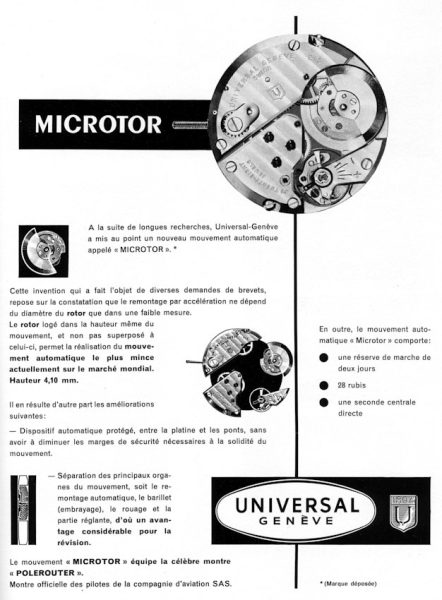
Advertising from 1958
On May 27, 1955, Universal patented a revolutionary automatic movement: the rotor does not cap the movement, but is integrated within it, enabling the creation of extremely slim calibers. But Universal was not the only manufacturer interested in these “planetary rotors” or “micro-rotors”. Hans Kocher, technical director of the Büren manufacture, had filed a patent on the subject on June 21, 1954, and therefore had the anteriority. Universal agreed to pay Büren a royalty of 4 Swiss francs per watch[21].
But this enabled both Büren and Universal to launch the thinnest automatic watches ever made in 1958: the movement of the Buren Super Slender was only 4.2 mm thick, and that of the Universal Microtor 4.1 mm, the thinnest in the world at the time. In 1959, Universal and Piaget co-signed a patent for a new automatic caliber with an even thinner micro-rotor, enabling Piaget, in return for a royalty payment to Büren, to launch the world’s thinnest automatic watch: the caliber was only 2.3 mm thick.
1959 also marked the birth of the European Common Market, which Switzerland did not join. To take advantage of existing business opportunities, Universal joined forces with the French company LIP to distribute its watches in France and Belgium[22]. At the same time, Universal acquired a stake in Lip. This collaboration continued in 1964, with Lip supplying Universal with electric calibers.
In 1960, Universal and Movado decided to collaborate[23]. This led to an exchange of calibers, with Movado being able to use micro-rotors, for example, but the joint effort focused mainly on electronics. The first electric watches from Hamilton and Lip were already on the market, and specialization in this totally new field for watchmakers was essential. A research center, called Moversal, was set up. For example, it was behind a pulse counter presented at the 1963 Salon de l’Électronique Industrielle[24] in Basel. Universal’s takeover by Bulova in 1966 put an end to this association.
With the gradual liberalization of the watchmaking statute in the early 1960s, Swiss manufacturers were subject to increased competition, and foreign companies could now buy up Swiss manufacturers. It was also a time of consolidation: Swiss manufacturers joined forces to pool their research departments and production sites.
In 1966, ASUAG created Chronos Holding with the aim of facilitating the concentration of watch manufacturers[25]. This objective was quickly achieved with the takeover of Cyma, Ernest Borel and Doxa, which were brought together under the holding company Synchron SA. Universal joined Chronos Holding on April 25, 1966, but, to everyone’s surprise, announced on August 29 that Universal had joined the American group Bulova Watch Co[26].
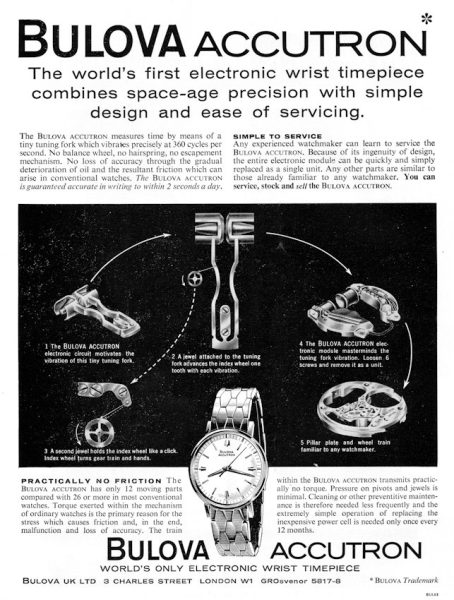
Advertising from 1965
For Bulova, it’s an excellent deal: Universal is present in Latin markets where Bulova is not represented, and Universal possesses remarkable automatic calibers that make slim, elegant watches. It’s also a response to Hamilton’s acquisition of Büren in the same year[27], giving it access to such high-performance automatic calibers.
For Universal, the benefits of joining Bulova are manifold[28]: retention of personnel and industrial facilities, reinforcement of research services in the electronics field, and greater resources for design and marketing. There may also have been a financial interest: according to some authors, Bulova’s takeover price was estimated at 1.5 million francs, whereas Chronos Holding had only offered 450,000 francs for the takeover of Cyma, a company of equivalent size[29].
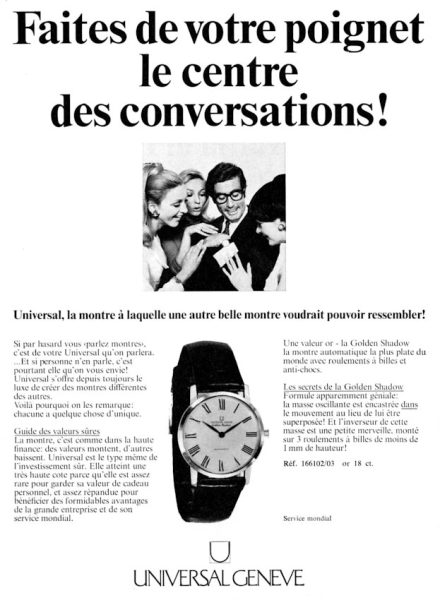
Advertising from 1967
1966 also saw the launch of the Golden Shadow (UG 66) automatic micro-rotor caliber, even thinner than its predecessor at 2.5 mm high.
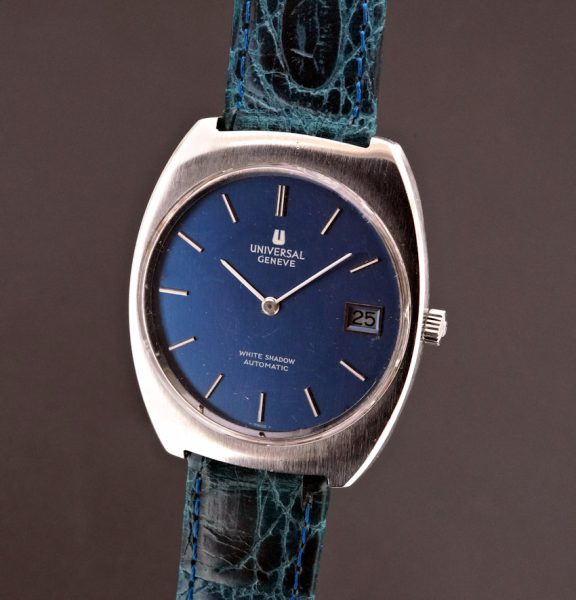
Universal White Shadow
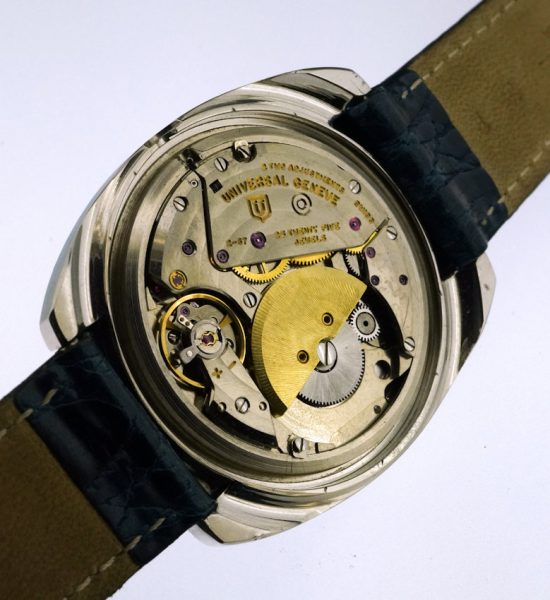
Calibre UG 67
1.2 From Bulova to Stelux
The Bulova takeover enabled Universal to use Accutron tuning-fork calibers, which Bulova had been manufacturing in Neuchâtel, Switzerland. This led to the launch in 1968 of the Unisonic ranges, including men’s and ladies’ watches, and even, in 1969, a diving model, Unisonic Sub.
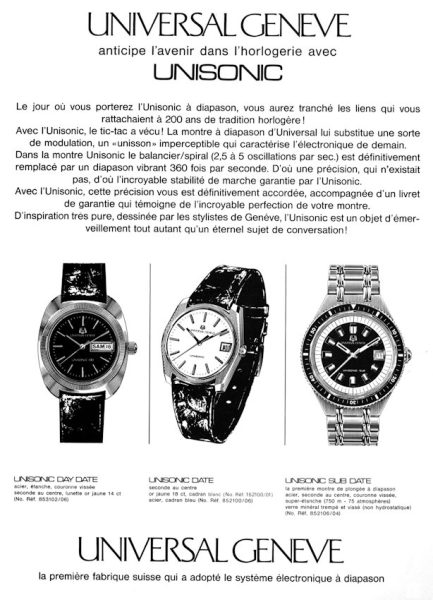
Advertising from 1970
In 1969, the Carouge factory was expanded to accommodate the success of the Unisonic watches[30].
In 1970, Universal launched its first “Uniquartz” quartz watches, thanks to the Beta 21 caliber developed by the Centre Électronique Horloger. An important change takes place at the head of the company: Diether Kübel-Wilsdorf is appointed Managing Director. Raoul Perret left the company’s board of directors[31] the following year, and the company lost its most emblematic figure.
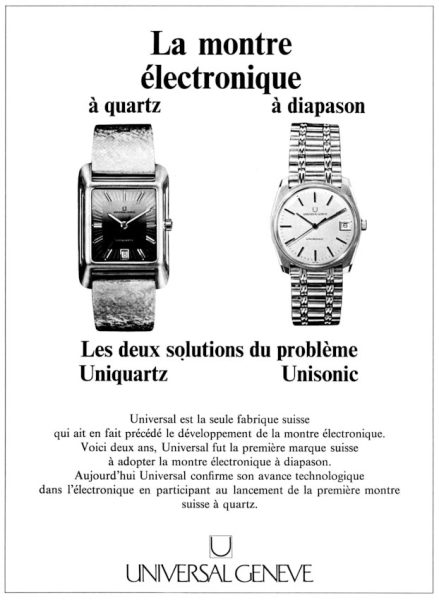
Advertising from 1970
In 1972, Universal receives an exceptional order for 50,000 watches for the Italian railroads[32].
In 1973, Universal inaugurates a new building to complete the Carouge factory[33]. Raoul Perret died the same year.
The Golden Shadow range now includes gold watches equipped with the UG 66 automatic caliber, while steel watches take on the White Shadow name.
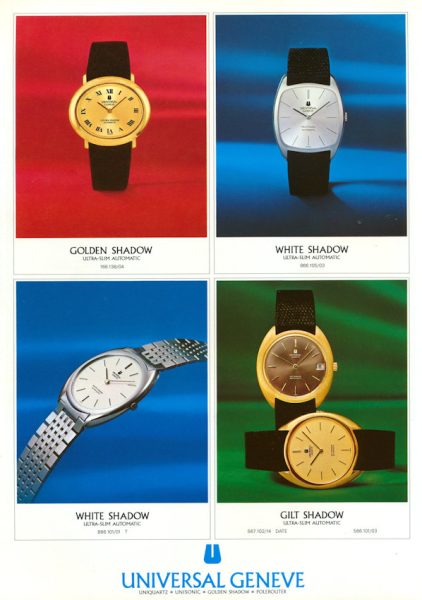
Advertising from 1975
In 1974, Universal used Bulova’s hybrid quartz/diapason caliber, but in 1975 introduced the world’s flattest quartz caliber (UG 74, 3.45 mm high)[34]. This is a modular caliber: the quartz is supplied by SSIH (Omega), the electronic module includes RCA components, the micromotor is supplied by Socrem (Société de Recherches en Matière de Micromoteurs Électroniques in Besançon, a Portescap subsidiary) and the mechanical part is Universal’s own, which also handles assembly.
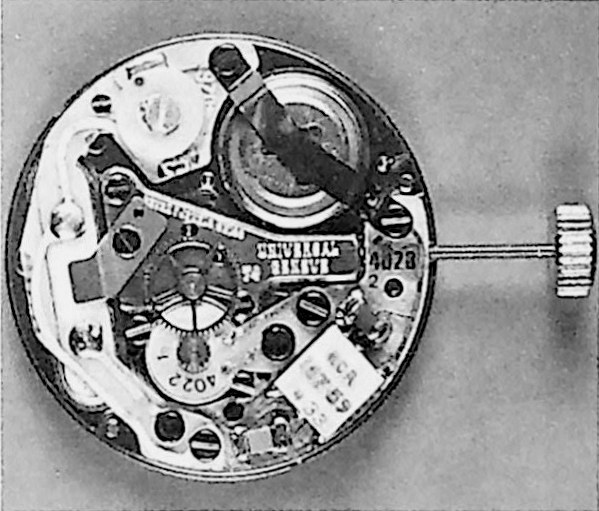
Calibre Universal Shadow Quartz
Roger Lebet, Universal’s Technical Director, is appointed President of the Société Suisse de Chronométrie.
In 1976, Stelux, a Hong Kong company specializing in watches, bracelets and electronic components, acquired a 27% stake in Bulova by buying out the shares held by Gulf and Western Industries[35].
In 1977, Sol Flick, vice-president of Bulova, became president of Universal and René Perret left the company. It was the end of the adventure for the company founders.
In 1978, Bulova was in difficulty and had to sell Universal. Diether Kübel-Wilsdorf bought the company[36] with the financial backing of Muraki Trading, Universal dealer in Japan, and Holzer Watch, Universal dealer in the USA.
In 1979 Universal launched a new in-house quartz caliber, UG 43, extra-flat (2.30 mm), and introduced a range of “dress” watches equipped with extra-flat movements. But success was not forthcoming. Difficulties mounted, and in 1982 Universal ceased production of its movements and the Carouge buildings were sold[37].
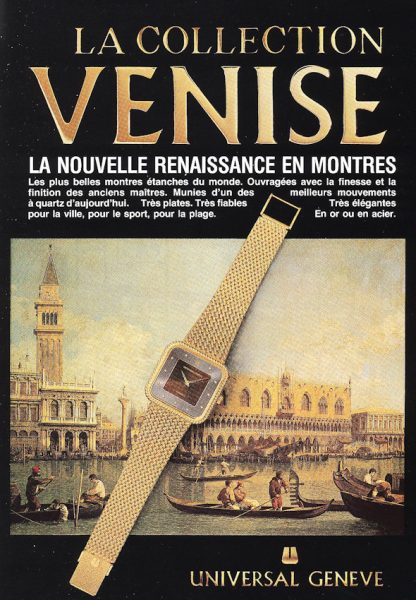
Advertising from 1981
In 1983, Universal went into debt-restructuring moratorium. Diether Kübel-Wilsdorf left the company. The machines were sold, and Universal was no longer a manufacture. In 1985, however, Jean-Claude Maibach left the company and was replaced by Parvis Hassan-Zadeh, who launched an “Islamic” watch, developed in collaboration with Spacetronic SA, to ring the hours of Islamic prayers. The gold quartz watch sold for the astronomical price of 42,000 francs[38].
In 1986, the Stelux group returned, bought the company and appointed a new president, Lennart Ödman. Several attempts to relaunch Universal followed, with numerous changes at the head of the company: new Polerouter models in 1987 with a design totally different from the original models, the Altesse and 66 collections in 1988 with automatic watches equipped with micro-rotor calibers still in stock, and the move to Thônex in 1989.
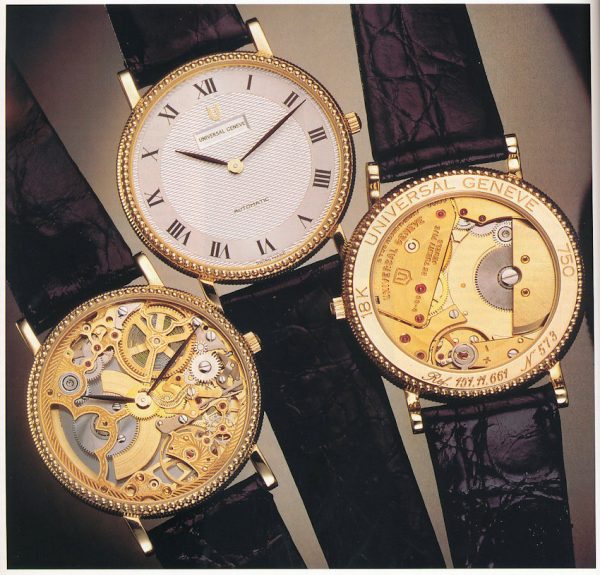
Universal watches from the 90’s with microtor calibres
In 1991, under the management of Charles Dom and Fred Santschi, Universal relaunches a range of Compax chronographs and rectangular watches in a neo-vintage spirit, as well as simple ETA-based watches.
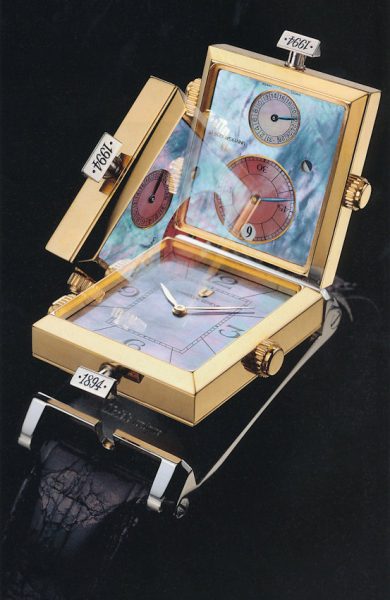
Golden Janus, 1994
In 1994, for Universal’s centenary, Vincent Calabrese created the Golden Janus watch, featuring a two-part case, the first in platinum fitted with a hinge allowing the second part to be turned over and exposing one of the watch’s two faces[39]. The first face shows the hours and minutes, while the other shows the time in a second time zone with jumping hour, the date and a day/night indication.
In 1995, Universal introduced the Golden Master Tech chronograph, followed the following year by the Golden Complitech and Golden Compax models.
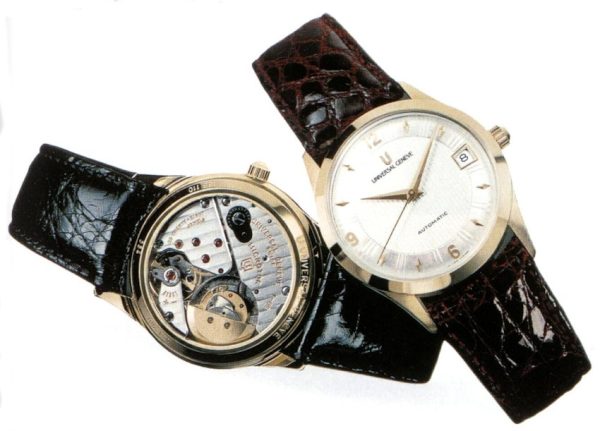
Golden Classic, 1996
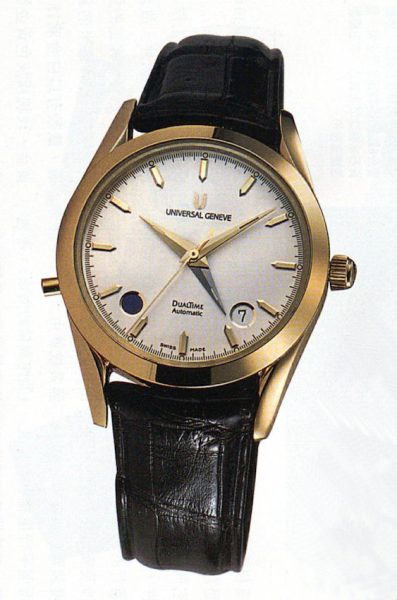
Golden Tech Dual Time, 1997
In 1997, while William Devine was CEO, Universal launched a watch with a second time zone, the Golden Tech Dual Time, chronographs named after racing driver Ayrton Senna with mechanical and quartz calibers, and a remarkable tourbillon watch by watchmaker Antoine Preziuso.
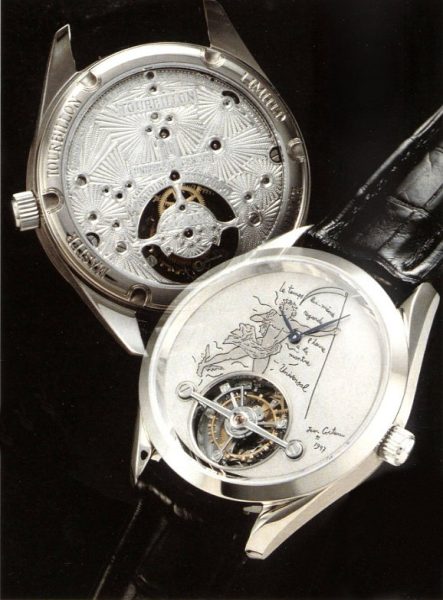
Universal Tourbillon, 1997
In 2001, Montres Universal SA becomes Universal Genève SA[40]. Launch of the Compax VQ and Compax Cirrus quartz chronographs.
In 2006, launch of the Okeanos Aero-Compax, based on Lémania, and presentation of a watch equipped with the new automatic micro-rotor caliber, Microtor UG100[41] (limited edition of 100). In 2008, this caliber will be used for a model with a cabriolet case. From then on, the Universal brand was mothballed.
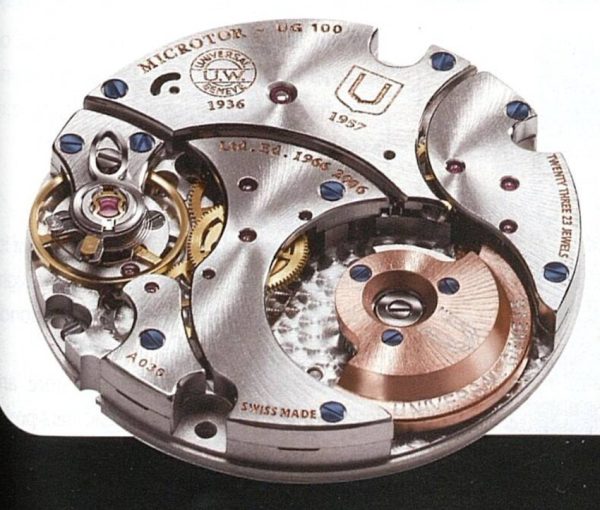
Calibre UG 100, 2006*
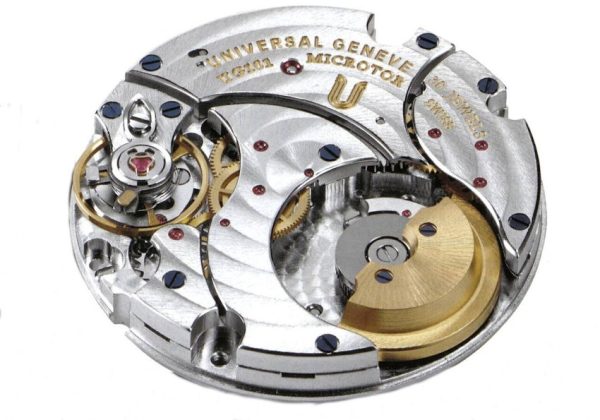
Calibre UG 101, 2007
In 2023, Universal Genève was acquired from Stelux by the Partners Group, owner of Breitling.
To be continued: Universal chronographs, the Polerouter, Universal “couturier de la montre”, etc…
Notes:
About Time To Tell: Time To Tell has one of the largest private digitized databases on the history of Swiss watchmaking, with over 2.3 TB of data on more than 1,000 Swiss watch manufacturers. This database has been built up over a period of some thirty years, and continues to be fed with around 50 to 100 GB of data every year. The database is made up of old documents, mostly Swiss trade magazines, dating from the late 19th to the late 20th century. Most of these documents are not available on the Internet. Historical articles published on time2tell.com always cite the sources used.
Time To Tell is a private company, independent of any watch manufacturer.
Concerning Universal Genève: Most online information about Universal has no credible sources. As a result, false information is repeated from site to site. This is the case, for example, with the release dates of the various Universal chronograph models or the origin of certain watches such as the Autorem. This article on Universal has taken several months to complete and is based solely on reliable historical sources. All sources used are referenced. However, this does not preclude errors or omissions. Any comments are welcome, and readers can contact us at timetotell@orange.fr
©Time To Tell, 2024
Reproduction forbidden without authorization. Any use of this article by an artificial intelligence is strictly forbidden and will be considered as copyright infringement.
[1] A good example is the article about Universal on Wikipedia: https://en.wikipedia.org/wiki/Universal_Gen%C3%A8ve, that accumulates historical errors
[2] Feuille Officielle Suisse du Commerce (FOSC) 1894
[3] Revue Internationale d'Horlogerie, 1947, 8, p. 25-27
[4] The company was registered as a trader and manufacturer
[5] Patent CH 8 014
[6] Patent CH 12 402
[9] Revue Internationale d'Horlogerie, 1915, 1, p. 37
[10] Raoul Perret, in Journal Suisse d'Horlogerie, 1961, 4, p. 421
[11] Journal Suisse d'Horlogerie, 1945, 11-12, p. 879
[14] Journal Suisse d'Horlogerie, 1940, 1 p. 38-39
[15] Journal Suisse d'Horlogerie, 1941, 1, p. 15
[18] Universal automatic watches can be found dating from the early 1930s. This is the Autorem system, an evolution of Eugène Meylan’s EMSA system, first used by Glycine.
[19] Journal Suisse d'Horlogerie, 1949, 11-12, p. 393
[20] Journal Suisse d'Horlogerie, 1956, 5-6, p. 252
[21] Hans Kocher, Une vie marquée par des hommes et des montres, édité par l'auteur, 1998, p. 31
[22] Journal Suisse d'Horlogerie, 1959, 1, p. 63
[23] Revue Internationale d'Horlogerie, 1960, 4, p. 19
[24] La Suisse Horlogère, édition Hebdomadaire, 1963, 36, p. 824
[25] Journal Suisse d'Horlogerie, 1966, 4, p. 471
[26] La Suisse Horlogère, édition hebdomadaire, 1966, 33, p. 976
[27] L'Impartial, 1966, 9 février, p. 19
[28] La France Horlogère, 1966, 254, p. 81
[29] La Suisse Horlogère, édition hebdomadaire, 1967, p. 1625
[30] Journal Suisse d'Horlogerie, 1969, 1, p. 130
[32] La Suisse Horlogère, édition hebdomadaire, 1972, 7, p. 188
[33] Journal Suisse d'Horlogerie, 1973, 6, p. 669
[34] La France Horlogère, 1975, 358, p. 123-124
[35] Bulletin de la Fédération Horlogère, 1976, 11, p. 20
[36] L'Impartial, 13 janvier 1978, p. 1
[37] Bulletin de la Fédération Horlogère, 1982, 19, p. 20
[38] L'Impartial, 10 avril 1985, p. 7
[39] Vincent Calabrese, Le temps d'une vie, Slatkine, 2016, p. 61
[41] It seems that this caliber was developed in collaboration with Les Artisans Horlogers, a design office created in 2004 by Manuel Spöde and Laurent Besse.
